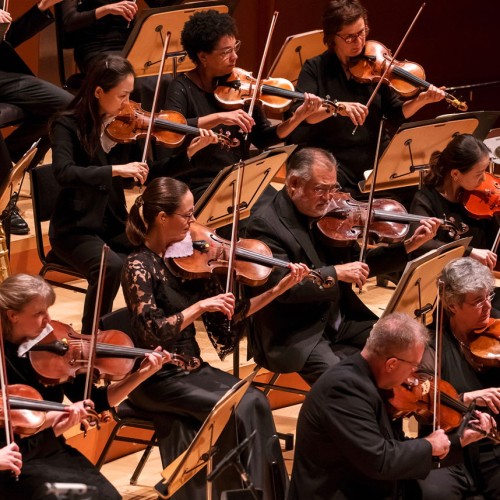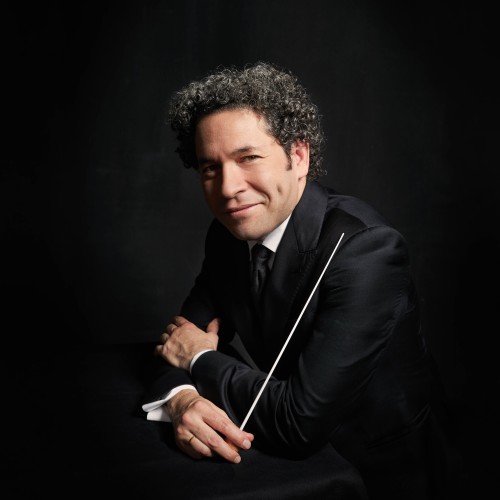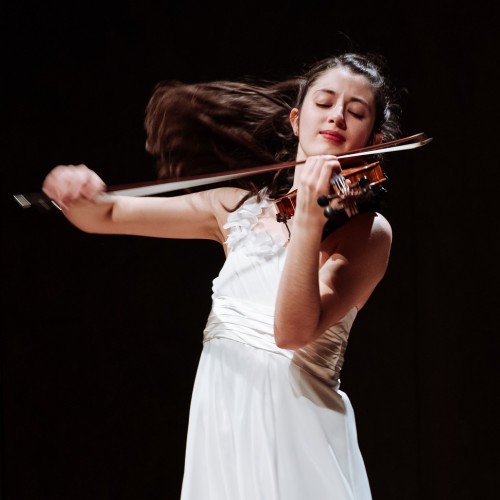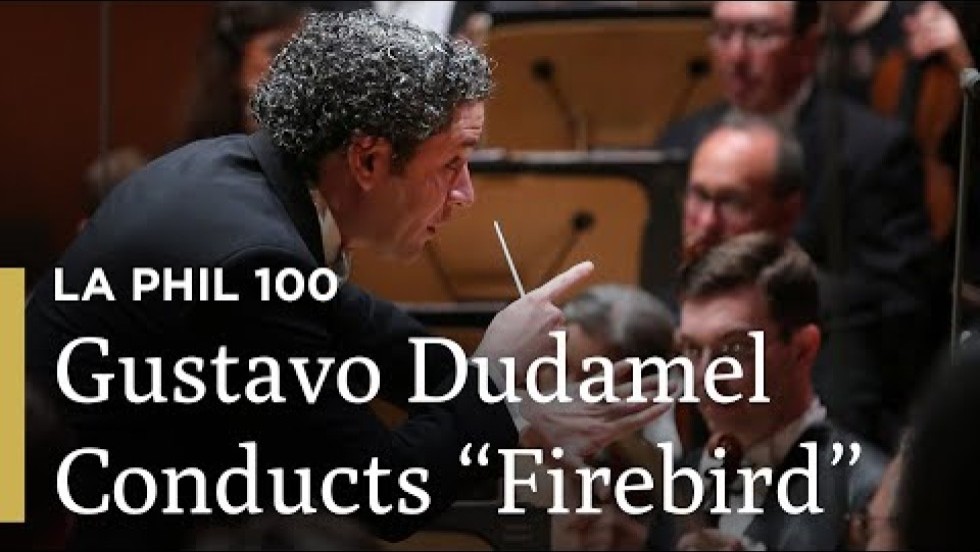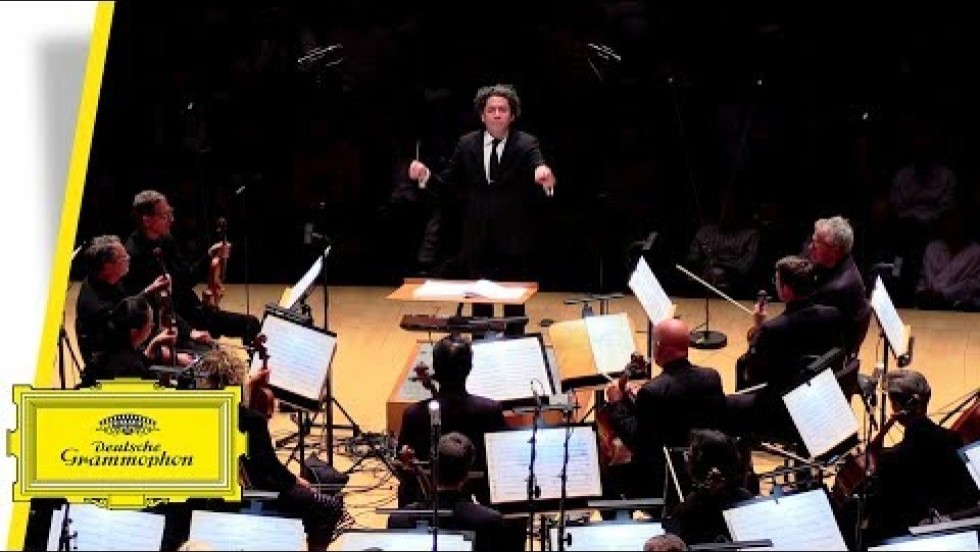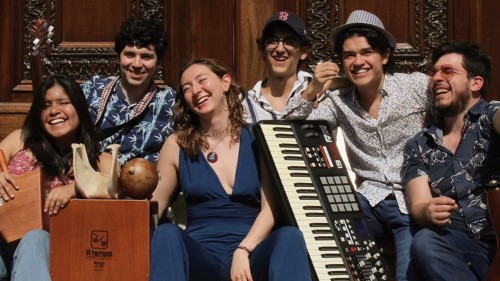
Los Angeles Philharmonic
Gustavo Dudamel, conductor // María Dueñas, violin
Cookie Notice
This site uses cookies to measure our traffic and improve your experience. By clicking "OK" you consent to our use of cookies.
Constant innovation and endless reinvention define the Los Angeles Philharmonic, and, once again, they are sure to thrill Boston audiences this fall. Since their last local performance in 2019, the ensemble has continued to harness the power of live classical music to foster community and artistic growth, commission new works, and showcase diverse performers and composers.
Now in his 12th season as music and artistic director, Gustavo Dudamel’s vision and creative direction has led the New York Times to herald the Los Angeles Philharmonic as “the most important orchestra in America—period.”
Joining Dudamel for the local premiere of a newly commissioned work by Mexican composer Gabriela Ortiz is the young and electrifying Spanish violinist María Dueñas. With this performance, Dueñas makes her Boston debut; she takes the stage with major orchestras all around the world in the coming season.
This can't-miss event closes—fittingly—with the mighty orchestra performing Mahler’s evocative and triumphant Symphony No. 1, the “Titan.”
There will be one 20-minute intermission between the two works.
Program Details
Movements:
1. Morisco chilango
2. Canto abierto
3. Maya déco
Gabriela Ortiz (b. 1964)
Composed: 2021
Length: c. 32 minutes
Orchestration: piccolo, 2 flutes, 2 oboes, 2 clarinets, 2 bassoons, 4 horns, 3 trumpets, 2 trombones, bass trombone, timpani, percussion (1=suspended cymbal, vibraphone, tambourine, tam-tam, guiro, maracas, snare drum; 2=crotales, glockenspiel, large gong, Tibetian singing bowls, xylophone, whip, congas; 3=triangle, gong, bongos, cymbals, snare drum, mark tree, temple block), harp, piano/celesta, strings, and solo violin
First Los Angeles Philharmonic performance: May 14, 2022, Gustavo Dudamel conducting, with María Dueñas, soloist
To date (May, 2022), Mexican composer Gabriela Ortiz has created seven works in the series of “musical altars,” and there is no reason to assume that she will not write more in the future. This is the full list so far:
Altar de neón (1995), for four percussionists and chamber orchestra
Altar de muertos (1997), for string quartet, water drums, and masks
Altar de piedra (2002), for three percussionists and orchestra
Altar de fuego (2010), for orchestra
Altar de luz (2013), for tape
Altar de viento (2015), for flute and orchestra
The fact is that for Gabriela Ortiz, the altar is not a religious concept; instead, its meaning for her tends more towards the symbolic, the spiritual, and the magic; an altar is a place to throw music into relief. Nonetheless, the first work in the series was in fact inspired by a true neon altar she came across in a church. In this most improbable image, she found a cultural syncretism, an erasure of borders, a conceptual eclecticism that can very well be synthesized in the idea of the postmodern, which happens to be one of the main aesthetic tendencies that define her music.
In recent years, Ortiz has established a close working relationship with the Los Angeles Philharmonic, a relationship which has produced several works and their respective premieres: Altar de piedra (2002), Téenek (2017), Pico-Bite-Beat (2018), Yanga (2019), and Kauyumari (2021). When in 2021 the opportunity for a further collaboration arose, the composer was ready (and willing) to write a violin concerto. Then, Gustavo Dudamel, the LA Phil’s Music Director, put forth the name of the brilliant young Spanish violinist María Dueñas. Thus, the stage was set for the creation of Altar de cuerda (“String Altar”), for violin and orchestra.
Tackling the issue of form in her new piece, Gabriela Ortiz proceeds according to tradition and chooses the usual three-movement structure, fast–slow–fast. In the first movement, “Morisco chilango” (“Chilango Moorish,” where “chilango” is a moniker for Mexico City natives), the composer has included a few subtle melodic turns which impart a vaguely Mediterranean flavor, a nod to María Dueñas’ Andalusian roots. More generally, “Morisco chilango” represents one more of Gabriela Ortiz’s visions on cultural appropriation and re-appropriation, an important theme in her musical thought. (She herself is, by the way, proudly chilanga).
In “Canto abierto” (“Open Song”), the distant reference is to the open chapels that were a common feature in 16th-century Mexican churches, built to catechize indigenous communities still reluctant to go inside a temple. Here, the composer’s operating principle is the creation of chords that are built and deconstructed, harmonies that slowly grow and contract like a sea swell that can be visually perceived in the score, while the solo violin lyrically floats over the sound waves. At the beginning and at the end of the movement, all wind players (both woodwind and brass) play tuned crystal glasses, which create an additional harmonic field.
“Maya déco” is a virtuosic, rhythmic, and fast-paced movement, with a constant dialogue between the solo violin and the orchestra; near the end of the piece, there is a fully written-out cadenza for the soloist.
The thoughtful listener will discover that there are references to architecture in all of Altar de cuerda’s three movements. On the one hand, this may be attributed to the fact that those cross-border appropriations that occupy the composer´s thoughts are particularly evident in architecture; on the other hand, it so happens that Gabriela Ortiz’s father, Rubén Ortiz Fernández, was not only a prominent music lover and a musician himself, but also an architect by profession.
It is worth noting that in all of Gabriela Ortiz’s Altars (except for Altar de luz) there is an important (and sometimes protagonistic) presence of percussion instruments; Altar de cuerda includes, besides timpani, three percussionists playing a role related more to color than to rhythm.
Gabriela Ortiz wrote Altar de cuerda between September and December 2021, on a commission from the Los Angeles Philharmonic Orchestra, and the work is, as it happens, the first concerto dedicated to María Dueñas.
—Juan Arturo Brennan
Movements:
1. Morisco chilango
2. Canto abierto
3. Maya déco
Gabriela Ortiz (b. 1964)
Composed: 2021
Length: c. 32 minutes
Orchestration: piccolo, 2 flutes, 2 oboes, 2 clarinets, 2 bassoons, 4 horns, 3 trumpets, 2 trombones, bass trombone, timpani, percussion (1=suspended cymbal, vibraphone, tambourine, tam-tam, guiro, maracas, snare drum; 2=crotales, glockenspiel, large gong, Tibetian singing bowls, xylophone, whip, congas; 3=triangle, gong, bongos, cymbals, snare drum, mark tree, temple block), harp, piano/celesta, strings, and solo violin
First Los Angeles Philharmonic performance: May 14, 2022, Gustavo Dudamel conducting, with María Dueñas, soloist
To date (May, 2022), Mexican composer Gabriela Ortiz has created seven works in the series of “musical altars,” and there is no reason to assume that she will not write more in the future. This is the full list so far:
Altar de neón (1995), for four percussionists and chamber orchestra
Altar de muertos (1997), for string quartet, water drums, and masks
Altar de piedra (2002), for three percussionists and orchestra
Altar de fuego (2010), for orchestra
Altar de luz (2013), for tape
Altar de viento (2015), for flute and orchestra
The fact is that for Gabriela Ortiz, the altar is not a religious concept; instead, its meaning for her tends more towards the symbolic, the spiritual, and the magic; an altar is a place to throw music into relief. Nonetheless, the first work in the series was in fact inspired by a true neon altar she came across in a church. In this most improbable image, she found a cultural syncretism, an erasure of borders, a conceptual eclecticism that can very well be synthesized in the idea of the postmodern, which happens to be one of the main aesthetic tendencies that define her music.
In recent years, Ortiz has established a close working relationship with the Los Angeles Philharmonic, a relationship which has produced several works and their respective premieres: Altar de piedra (2002), Téenek (2017), Pico-Bite-Beat (2018), Yanga (2019), and Kauyumari (2021). When in 2021 the opportunity for a further collaboration arose, the composer was ready (and willing) to write a violin concerto. Then, Gustavo Dudamel, the LA Phil’s Music Director, put forth the name of the brilliant young Spanish violinist María Dueñas. Thus, the stage was set for the creation of Altar de cuerda (“String Altar”), for violin and orchestra.
Tackling the issue of form in her new piece, Gabriela Ortiz proceeds according to tradition and chooses the usual three-movement structure, fast–slow–fast. In the first movement, “Morisco chilango” (“Chilango Moorish,” where “chilango” is a moniker for Mexico City natives), the composer has included a few subtle melodic turns which impart a vaguely Mediterranean flavor, a nod to María Dueñas’ Andalusian roots. More generally, “Morisco chilango” represents one more of Gabriela Ortiz’s visions on cultural appropriation and re-appropriation, an important theme in her musical thought. (She herself is, by the way, proudly chilanga).
In “Canto abierto” (“Open Song”), the distant reference is to the open chapels that were a common feature in 16th-century Mexican churches, built to catechize indigenous communities still reluctant to go inside a temple. Here, the composer’s operating principle is the creation of chords that are built and deconstructed, harmonies that slowly grow and contract like a sea swell that can be visually perceived in the score, while the solo violin lyrically floats over the sound waves. At the beginning and at the end of the movement, all wind players (both woodwind and brass) play tuned crystal glasses, which create an additional harmonic field.
“Maya déco” is a virtuosic, rhythmic, and fast-paced movement, with a constant dialogue between the solo violin and the orchestra; near the end of the piece, there is a fully written-out cadenza for the soloist.
The thoughtful listener will discover that there are references to architecture in all of Altar de cuerda’s three movements. On the one hand, this may be attributed to the fact that those cross-border appropriations that occupy the composer´s thoughts are particularly evident in architecture; on the other hand, it so happens that Gabriela Ortiz’s father, Rubén Ortiz Fernández, was not only a prominent music lover and a musician himself, but also an architect by profession.
It is worth noting that in all of Gabriela Ortiz’s Altars (except for Altar de luz) there is an important (and sometimes protagonistic) presence of percussion instruments; Altar de cuerda includes, besides timpani, three percussionists playing a role related more to color than to rhythm.
Gabriela Ortiz wrote Altar de cuerda between September and December 2021, on a commission from the Los Angeles Philharmonic Orchestra, and the work is, as it happens, the first concerto dedicated to María Dueñas.
—Juan Arturo Brennan
Gustav Mahler (1860–1911)
Composed: 1884-1888, rev. 1893, 1896, 1899
Length: c. 55 minutes
Orchestration: 4 flutes (2nd, 3rd, and 4th=piccolo), 4 oboes (3rd=English horn), 4 clarinets (3rd=bass clarinet and E-flat clarinet, 4th=E-flat clarinet), 3 bassoons (3rd=contrabassoon), 7 horns, 4 trumpets, 3 trombones, tuba, percussion (bass drum, cymbals, gong, triangle), 2 timpani, harp, and strings
First Los Angeles Philharmonic performance: March 1, 1928, Georg Schnéevoigt conducting
The genesis of Mahler’s First Symphony was protracted—15 years separate his first thoughts from his final revision. During that time, the young composer went from apprentice to journeyman to master. In 1884, when he first scribbled down themes that would eventually find their way into the Symphony, Mahler was conductor of the opera in Kassel, a modest post. By the time the work achieved its final form, he was director of the Court Opera in Vienna. The years in between had taken him to Prague, Leipzig, Budapest (where the First Symphony premiered in its original, five-movement version in 1889), and Hamburg, as well as a two-month stint as a guest conductor at Covent Garden in London.
The Symphony, too, had seen as many cities. After its Budapest premiere, Mahler revised it for performances in Hamburg (1893) and Weimar (1894), finally excising an entire movement and premiering the work in (nearly) its present form in Berlin in 1896. The version published in 1899 reflects further revision, primarily to the work’s orchestration.
Several facts about Mahler the composer emerge in connection with this Symphony. First and foremost, his activities as a composer of songs were inextricably intertwined with his work as a symphonist. In this case, themes from his Songs of a Wayfarer, which he started in 1893, play a central role in the First Symphony’s opening and third movements.
Mahler also needed an extramusical stimulus to get started on his symphonies, but would later discard that program, usually a mark that the work had achieved its final form. Here, Mahler began with an elaborate program derived from early German Romantic writers Jean Paul and E.T.A. Hoffmann—writers whose ecstatic nature imagery and descriptions of the grotesque and macabre certainly left their mark on Mahler’s music—and the Italian medieval poet Dante Alighieri—the Symphony’s finale at one time bore the descriptive title “Dall’Inferno al Paradiso.” The visual arts also played a role, especially the woodcut The Hunter’s Funeral Procession (1850) by Moritz von Schwind, in which the animals of the forest carry the bier of the dead hunter, a key impetus for the third movement funeral procession.
But Mahler eventually distanced himself from these influences, leaving a four-movement symphony with a sonata-allegro opening, a spirited and earthy dance movement, the funeral procession, and a finale whose storm dissolves in light. And though a product of his journeyman years, the First Symphony, in its final form, already affirms Mahler’s complete mastery, an unequivocal announcement that the wayfarer has definitely arrived.
–John Mangum
Gustav Mahler (1860–1911)
Composed: 1884-1888, rev. 1893, 1896, 1899
Length: c. 55 minutes
Orchestration: 4 flutes (2nd, 3rd, and 4th=piccolo), 4 oboes (3rd=English horn), 4 clarinets (3rd=bass clarinet and E-flat clarinet, 4th=E-flat clarinet), 3 bassoons (3rd=contrabassoon), 7 horns, 4 trumpets, 3 trombones, tuba, percussion (bass drum, cymbals, gong, triangle), 2 timpani, harp, and strings
First Los Angeles Philharmonic performance: March 1, 1928, Georg Schnéevoigt conducting
The genesis of Mahler’s First Symphony was protracted—15 years separate his first thoughts from his final revision. During that time, the young composer went from apprentice to journeyman to master. In 1884, when he first scribbled down themes that would eventually find their way into the Symphony, Mahler was conductor of the opera in Kassel, a modest post. By the time the work achieved its final form, he was director of the Court Opera in Vienna. The years in between had taken him to Prague, Leipzig, Budapest (where the First Symphony premiered in its original, five-movement version in 1889), and Hamburg, as well as a two-month stint as a guest conductor at Covent Garden in London.
The Symphony, too, had seen as many cities. After its Budapest premiere, Mahler revised it for performances in Hamburg (1893) and Weimar (1894), finally excising an entire movement and premiering the work in (nearly) its present form in Berlin in 1896. The version published in 1899 reflects further revision, primarily to the work’s orchestration.
Several facts about Mahler the composer emerge in connection with this Symphony. First and foremost, his activities as a composer of songs were inextricably intertwined with his work as a symphonist. In this case, themes from his Songs of a Wayfarer, which he started in 1893, play a central role in the First Symphony’s opening and third movements.
Mahler also needed an extramusical stimulus to get started on his symphonies, but would later discard that program, usually a mark that the work had achieved its final form. Here, Mahler began with an elaborate program derived from early German Romantic writers Jean Paul and E.T.A. Hoffmann—writers whose ecstatic nature imagery and descriptions of the grotesque and macabre certainly left their mark on Mahler’s music—and the Italian medieval poet Dante Alighieri—the Symphony’s finale at one time bore the descriptive title “Dall’Inferno al Paradiso.” The visual arts also played a role, especially the woodcut The Hunter’s Funeral Procession (1850) by Moritz von Schwind, in which the animals of the forest carry the bier of the dead hunter, a key impetus for the third movement funeral procession.
But Mahler eventually distanced himself from these influences, leaving a four-movement symphony with a sonata-allegro opening, a spirited and earthy dance movement, the funeral procession, and a finale whose storm dissolves in light. And though a product of his journeyman years, the First Symphony, in its final form, already affirms Mahler’s complete mastery, an unequivocal announcement that the wayfarer has definitely arrived.
–John Mangum
Featured Artists
“Poised and unshowy, she [Dueñas] owns this exceedingly difficult concerto [by Gabriela Ortiz]. Her tone is slender but so purposefully focused that it easily carries. You can tell that it is purposeful, because when Ortiz asks for a plum-rich, vibrating expressiveness, she manages that brilliantly.”
Mark Swed Los Angeles Times
“What defines the Los Angeles Philharmonic? Is it the music and artistic director Gustavo Dudamel’s exciting performances of symphonies central to the repertory? Or is it the risks the orchestra takes on rarities and new pieces…The fact that the answer is, truly, “both” is a testament to the Philharmonic’s excellence on more fronts than almost any other ensemble.”
The New York Times
Gustavo Dudamel and María Dueñas with the Los Angeles Philharmonic, October 2022

Violinist María Dueñas performs with the Los Angeles Philharmonic

The Los Angeles Philharmonic with Gustavo Dudamel performs Mahler's First Symphony
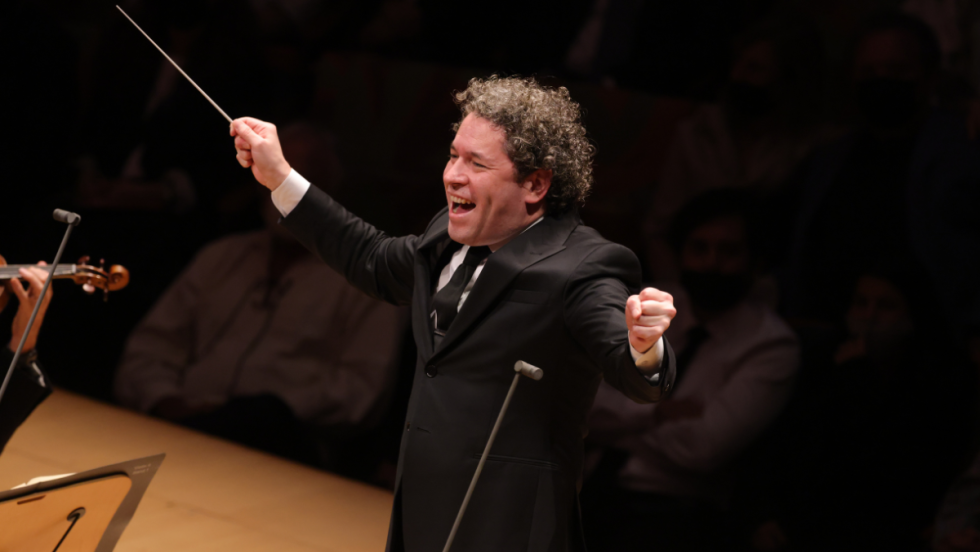
Gustavo Dudamel conducts the Los Angeles Philharmonic

Violinist María Dueñas performs with the Los Angeles Philharmonic

The Los Angeles Philharmonic with Gustavo Dudamel performs Mahler's First Symphony

Gustavo Dudamel conducts the Los Angeles Philharmonic
Videos
Symphony Hall Information
This performance is generously sponsored by
Stephanie L. Brown Foundation.
Related Events


Kalia Vandever, trombone & Charles Overton, harp
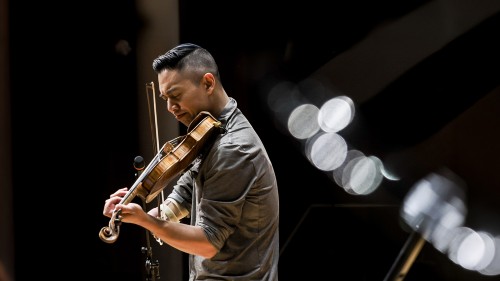
Adrian Anantawan & Friends
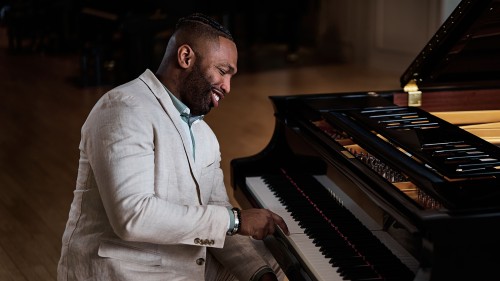
John Paul McGee Jazz Trio

J’Nai Bridges, mezzo-soprano

Music From The Sole
House is Open, Going Dark
Stay in touch with Celebrity Series of Boston and get the latest.
Email Updates Sign up for Email Updates